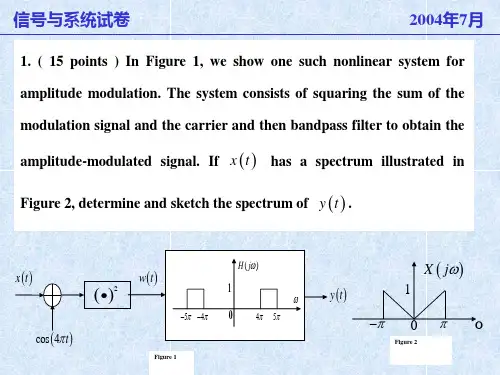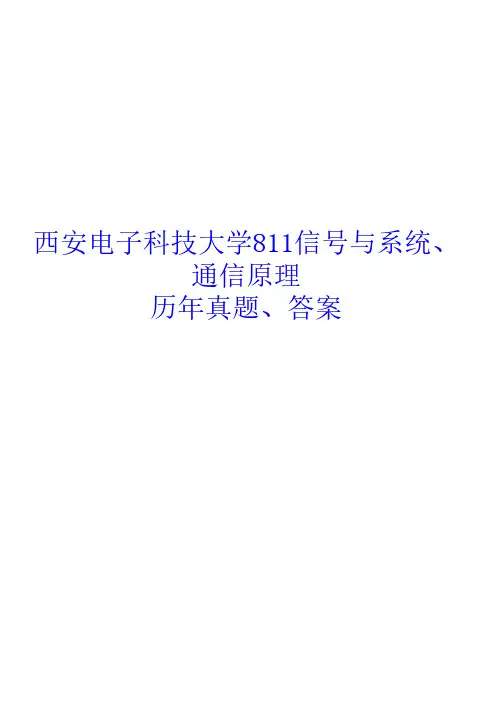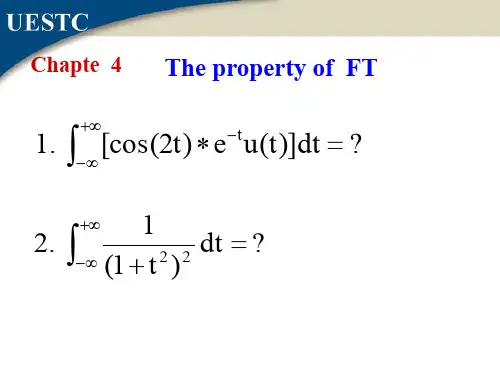电子科大讲义课堂信号与系统考卷
- 格式:ppt
- 大小:263.00 KB
- 文档页数:6
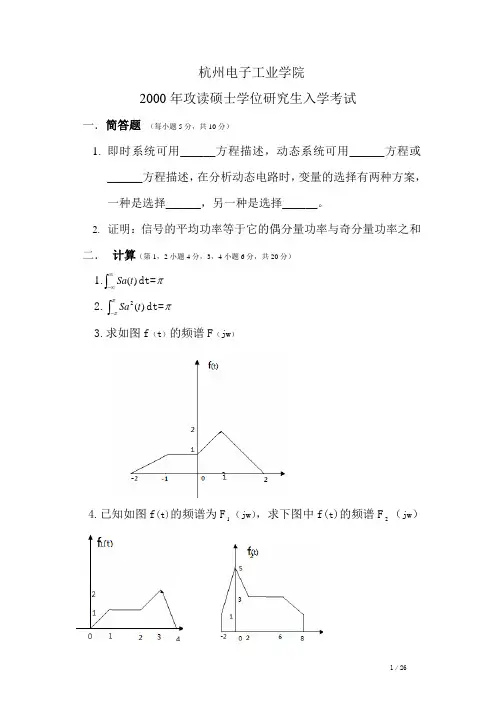
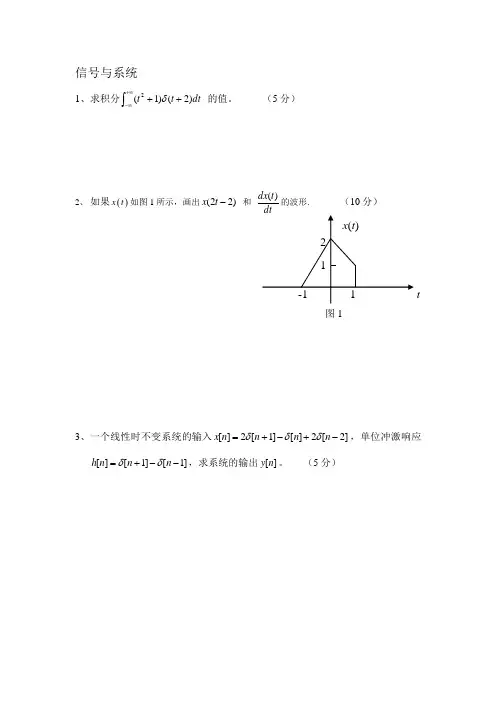
信号与系统1、求积分⎰+∞∞-++dt t t )2()1(2δ 的值。
(5分)2、 如果()x t 如图1所示,画出)22(-t x 和t dx )(的波形. (10分)图13、一个线性时不变系统的输入]2[2][]1[2][-+-+=n n n n x δδδ,单位冲激响应]1[]1[][--+=n n n h δδ,求系统的输出][n y 。
(5分)t4、一个线性时不变系统的输入为)(1tx时,输出为)(1ty。
若输出信号为)(2tx,求输出信号)(2ty。
各信号如图2所示。
(5分)图25、已知)1()()(--=tututx,)2/()(txth=,求)(*)()(thtxty=。
(5分)6、一个线性时不变系统的单位冲激响应为 )2sin 8(sin 1)(t t tt h πππ-=, 如果输入信号为 t t t x ππ6sin 4cos 1)(++=, 求输出信号()y t .(10分)7、 设 ()x t 是一个带限信号,()x t 的频谱满足()0 for 100X j ωωπ=>。
现对)()(2t x t y =冲激串采样,得到()()()p n y t y nT t nT δ+∞=-∞=-∑求采样间隔 T 的范围使得 ()t y 能由信号()t y p 恢复。
(10分)8、(15分)一个稳定的线性时不变系统,其微分方程如下)()()(6)(5)(22t x dtt dx t y dtt dy dtt y d +=++1) 求系统函数H(S),决定H(S)的收敛域。
2)求系统的单位冲激响应()h t ,判定系统是否因果。
3)画出系统的模拟方框图。

………密………封………线………以………内………答………题………无………效……电子科技大学二零 一 一 至二零 一 二 学年第 一 学期期 中 考试SIGNALS AND SYSTEMS 课程考试题 卷 ( 120 分钟) 考试形式: 闭卷 考试日期 20 11 年 月 日课程成绩构成:平时 10 分, 期中 20 分, 实验 10 分, 期末 60 分1(56points).Each of the following questions may have one or two right answers, justify your answers and write it in the blank. (1)()cos 221πδ+∞-∞-=⎰t t dt ( ).(a) 1 (b) -1 (c) 0.5 (d) -0.5 (2) The fundamental period of the signal[]23cos sin 32ππ⎡⎤⎡⎤=-⎢⎥⎢⎥⎣⎦⎣⎦x n n n is ( ). (a) 12N = (b) 6N = (c) 8N = (d) 24N =(3) Let ()1tx t e -= and ()()()14k x t x t t k δ+∞=-∞=*-∑. The Fourier series coefficients of ()x t may be ( ).(a) {} and Im 0-==k k k a a a (b) {} and Im 0-=-=k k k a a a (c) {} and Re 0-==k k k a a a (d) {} and Re 0k k k a a a -=-=(4) Consider an LTI system with unit impulse response ()h t illustrated in Figure 1, if the input is ()()d t x t dtδ= , the output () 0.5t y t =- is( ).(a) -1 (b) 1 (c) -0.5 (d) 0.5(5) The convolution integral ()222tte e u t -*=( ).(a) 2 (b)214t e (c) 212t e (d) ()212t e u t(6) Which of the following systems is an linear system ( ). In each example, []y n denotes the system output and []x n is the systeminput.(a) [][][]cos y n n x n = (b) [][]{}cos 3y n x n = (c) [][]()ln y n x n = (d) [][]2y n x n =(7) Which of the following systems are causal and stable system ( ). In each example, ()h t denotes the impulse response of thefollowing systems.(a) ()()()13h t t t δδ=-+- (b) ()()()0.5cos 2t h t t e u t =- (c) ()()()13h t t t δδ=+++ (d) ()()()cos 2t h t t e u t -=-(8) Determine which of the following signals with finite total energy ( ). (a) []()[]1x n n u n =+ (b) ()()23tx t e u t -=+(c) []()[]1cos /32nx n n u n π⎛⎫= ⎪⎝⎭(d) () , tx t e t =-∞<<+∞tFigure 1………密………封………线………以………内………答………题………无………效……(9) Consider a continuous-time LTI system whose frequency response is ()()sin /2H j ωωω=. If we know the output ()y t to some periodicinput signals are ()0y t =. The fundamental period of the input signal may be ( ). (a) 1T = (b) 2T = (c) 0.5T = (d) 3T =(10) The completely equivalent definition of the unit impulse function()δt are ( ).(a) We can define ()δt as the signal for which ()()()δ=*x t x t t for any ()x t . (b) ()sin limωωδπ→∞=c c tt t(c) () 0 00 0δ≠⎧=⎨≠=⎩t t t and()1δ+∞-∞=⎰t dt(d) () 0 0δ≠⎧=⎨∞=⎩t t t2(12points). A continuous-time signal ()32-+x t is illustrated in Figure 2. (a) Determine the signal ()x t . (b) Sketch and label carefully ()x t .3(10 points).Consider an LTI system whose response to the signal ()t x 1 in Figure 3 is the signal ()t y 1 illustrated in Figure 4. Determine the response of the system to the input ()t x 2 depicted in Figure 5 .Figure 3tFigure 2………密………封………线………以………内………答………题………无………效……4(12 points). Consider a continuous-time LTI system whose frequency response ()H j ω is illustrated in Figure 6. If the input signal()1cos3sin6ππ=++x t t t , determine the output ()y t of the system.14(10points). Consider an LTI system whose input []x n and unit impulse response []h n are given by []{}1,0,1,1,0,1x n n =-=-,[]{}2,1,3,2,2,3,4,5h n n ==. Determine the output [][][]n h n x n y *= of this system.ωFigure 6。
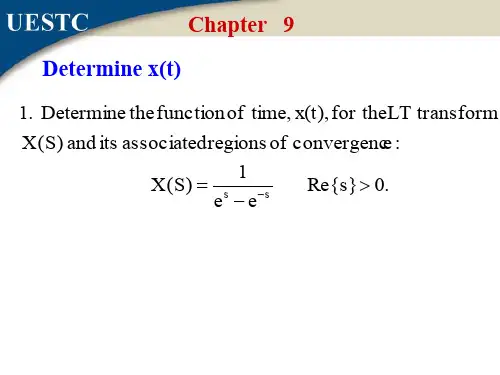
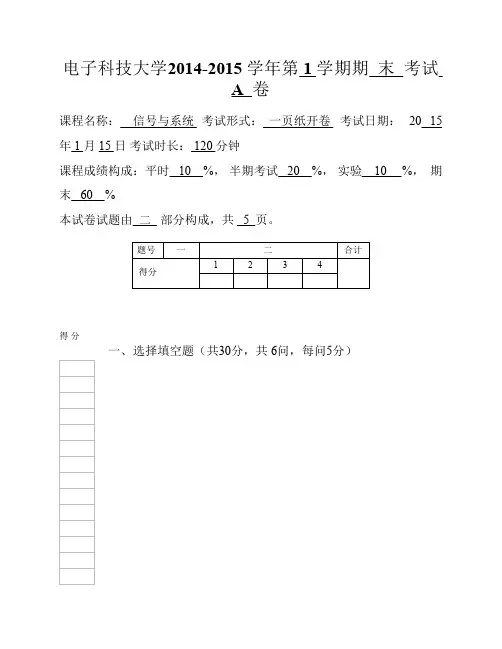
电子科技大学2014-2015 学年第 1 学期期末考试A 卷课程名称:信号与系统考试形式:一页纸开卷考试日期:20 15年 1 月 15 日考试时长: 120 分钟课程成绩构成:平时 10 %,半期考试 20 %,实验 10 %,期末 60 %本试卷试题由二部分构成,共 5 页。
题号一二合计1234得分得分一、选择填空题(共30分,共 6问,每问5分)1.Consider two signals and , as shown in Figure 1. The Fourier transform of is . Then the Fourier transform ofshould be().(a)(b)(c)(d)Figure 1 The waveforms of and2. The convolution sum ( ).(a) (b) (c) (d) not existed3. Consider a stable discrete-time system, whose system function is a rational function and has only two poles:. The positions of zeros are unknown. The impulse response of the system must be ( ).(a) finite duration (b) right-sided (c) left-sided (d) two sided4.The relation between the input and the output of a causal continuous-time LTI system is described by the differential equation . The system is ().(a) Low-pass filter (b) Band-pass filter (c) High-pass filter (d) Band-stop filter5.The Fourier transform of the signal is shown in Figure 2.The signal may beFigure 2(a) real and even (b) real and odd(c) pure imaginary and odd (d) pure imaginary and even6. The Laplace Transform of is ().(a) , (b) ,(c) , (d) ,二、计算题(共70分)得分1.(15 points)Suppose and are both band-limited signals, where.Impulse-train sampling is performed on to obtain , as shown inFigure 3 where .Deduce the value of so that for .Specify the range ofvalues for the sampling period T which ensures that =.32.( 18 points ) Consider an LTI system with unit impulseresponse .The input signal ,where is the unit stepfunction.得分(a) Sketch. (b) Determine the magnitude and phase responseof this system. (c) Determine the output .3(17分)A causal continuous-time LTI system is given in Figure 4.(a)Determine the range of the constant K toensure that the system is stable.(b)If K=2, determine the unit step response.1/S-31/S-2KFigure 44(20 分)Suppose that we are given the following information about a causal discrete-time LTI system:(1)If the input is ,then the output is .(2)The value of the unit impulse response at n=0 is .Solve the following problems:(a) Determine the system function ,and indicate its ROC.(b) Draw a block diagram representation of this system.(c) Determine the unit impulse response .(d) Suppose. Determine the range of real numberso that is the unit impulse response of a stable system.。
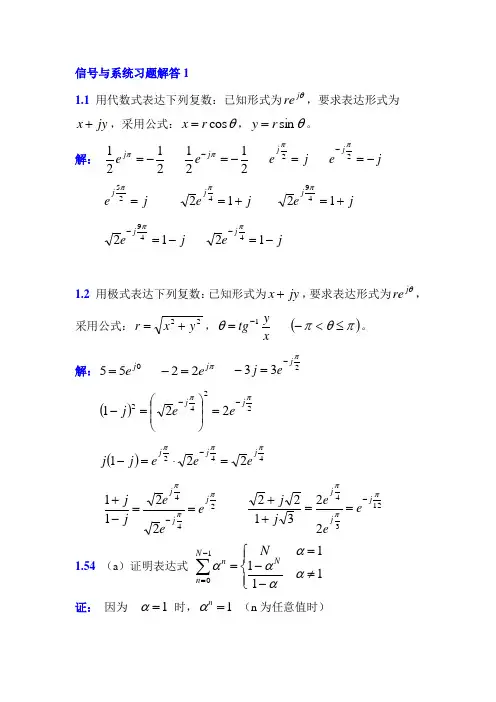
信号与系统习题解答11.1 用代数式表达下列复数:已知形式为θj re ,要求表达形式为jy x +,采用公式:θcos r x =,θsin r y =。
解: 2121-=πj e 2121-=-πj ej e j =2π j e j -=-2πj ej=25πj ej+=124π j ej+=1249πj ej -=-1249π j ej-=-124π1.2 用极式表达下列复数:已知形式为jy x +,要求表达形式为θj re ,采用公式:22y x r +=,()πθπθ≤<-=-xytg 1。
解:055j e = πj e 22=- 233πjej -=-()2242221ππjj e e j --=⎪⎪⎭⎫ ⎝⎛=- ()442221πππjjje eej j =⋅=--2442211πππjjje ee jj ==-+-1234223122πππjj je e ej j -==++1.54 (a )证明表达式 ⎪⎩⎪⎨⎧≠--==∑-=111110αααααN N n nN证: 因为 1=α 时,1=n α (n 为任意值时)所以,1=α 时,N N n n =∑-=10α因为 ()()NN ααααα-=++++--1 (111)2所以,当1≠α时,()ααααα--=++++-11 (11)2NN 原式得证。
(b) 证明:1<α时,αα-=∑∞=110n n 证:因为 1<α时,0lim ==∞→NN α所以:αααα-=--=∞→∞=∑1111lim 0N N n n(c )证明:1<α时,()21ααα-=∑∞=n nn 证:令()αααf n n=-=∑∞=11为α的连续函数对上式进行微分运算可得:()()2111αααα-==∑∞=-n n n d df 同时乘以α就可以得到:()21αααααα-==∑∞=n nn d df (d )当1<α时,计算?=∑∞=kn nα解: 因为∑∑∑∞=-=∞=+=kn nk n n n n ααα100所以:αααααααα-=----=-=∑∑∑-=∞=∞=1111110kk k n nn nk n n1.55 计算下列和式,采用代数式表达。

………密………封………线………以………内………答………题………无………效……电子科技大学二零 一 一 至二零 一 二 学年第 一 学期期 中 考试SIGNALS AND SYSTEMS 课程考试题 卷 ( 120 分钟) 考试形式: 闭卷 考试日期 20 11 年 月 日课程成绩构成:平时 10 分, 期中 20 分, 实验 10 分, 期末 60 分1(56points).Each of the following questions may have one or two right answers, justify your answers and write it in the blank. (1)()cos 221πδ+∞-∞-=⎰t t dt ( d ).(a) 1 (b) -1 (c) 0.5 (d) -0.5(2) The fundamental period of the signal []23cos sin 32ππ⎡⎤⎡⎤=-⎢⎥⎢⎥⎣⎦⎣⎦x n n n is ( a ). (a) 12N = (b) 6N = (c) 8N = (d) 24N = (3) Let ()1tx t e -= and ()()()14k x t x t t k δ+∞=-∞=*-∑. The Fourier series coefficients of ()x t may be ( a ).(a) {} and Im 0-==k k k a a a (b) {} and Im 0-=-=k k k a a a (c) {} and Re 0-==k k k a a a (d) {} and Re 0k k k a a a -=-=(4) Consider an LTI system with unit impulse response ()h t illustrated in Figure 1, if the input is ()()d t x t dtδ=, the output () 0.5t y t =- is( b ).(a) -1 (b) 1 (c) -0.5 (d) 0.5(5) The convolution integral ()222t te e u t -*=( c ).(a) 2 (b)214te (c)212te (d)()212te u t(6) Which of the following systems is an linear system ( a ). In each example, []y n denotes the system output and []x n is the systeminput.(a) [][][]cos y n n x n = (b) [][]{}cos 3y n x n = (c) [][]()ln y n x n = (d) [][]2y n x n =(7) Which of the following systems are causal and stable system ( ad ). In each example, ()h t denotes the impulse response of thefollowing systems.(a) ()()()13h t t t δδ=-+- (b) ()()()0.5cos 2t h t t e u t =- (c) ()()()13h t t t δδ=+++ (d) ()()()cos 2t h t t e u t -=-(8) Determine the following signals which have finite total energy ( bc ). (a) []()[]1x n n u n =+ (b) ()()23tx t eu t -=+(c) []()[]1cos /32nx n n u n π⎛⎫= ⎪⎝⎭(d) () , tx t e t =-∞<<+∞tFigure 1………密………封………线………以………内………答………题………无………效……(9) Consider a continuous-time LTI system whose frequency response is ()()sin /2Hj ωωω=. If we know the output ()y t to some periodicinput signals are ()0y t =. The fundamental period of the input signal may be ( ac ). (a) 1T = (b) 2T = (c) 0.5T = (d) 3T =2(12points). A continuous-time signal ()32-+x t is illustrated in Figure 2.(a) Determine the signal ()x t . (b) Sketch and label carefully ()x t .3(10 points).Consider an LTI system whose response to the signal ()t x 1 in Figure 3 is the signal ()t y 1 illustrated in Figure 4. Determine the response of the system to the input ()t x 2 depicted in Figure 5 .4(12 points). Consider a continuous-time LTI system whose frequency response ()H j ω is illustrated in Figure 6. If the input signal()1cos 3sin 6ππ=++x t t t , determine the output of the system.12Figure 3ωFigure 6tFigure 2………密………封………线………以………内………答………题………无………效……14(10points). Consider an LTI system whose input []x n and unit impulse response []h n are given by []{}1,0,1,1,0,1x n n =-=-,[]{}2,1,3,2,2,3,4,5h n n ==. Determine the output [][][]n h n x n y *= of this system.《信号与系统》半期考试评分标准说明1.填空题(56分)⑴. (d) ⑵ (a) ⑶ (a) ⑷ (b) ⑸ (c) ⑹ (a) ⑺ (ad) ⑻ (bc) ⑼ (ac) ⑽ (ab) 本部分评分规则:1) 选择题共14个正确答案,1-6题为单选,7-10题为双选; 2) 若只填写了1个答案,正确得4分,错误得0分;3) 若填写了2个答案,2个正确得8分,1个正确、1个错误得4分,2个错误得0分;4) 若填写了3个答案,2个正确、1个错误得4分,1个正确、2个错误得2分,3个错误得0分; 5) 若填写了4个答案,得0分。
